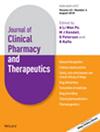依托咪酯-异丙酚混合物与地佐辛抑制胃镜插入反应的中位有效剂量:Dixon上下法随机对照研究中的性别差异
IF 2.1
4区 医学
Q3 PHARMACOLOGY & PHARMACY
引用次数: 0
摘要
已知的和客观的。适当剂量的镇静剂对于成功的无痛上消化道内窥镜检查至关重要。因此,我们进行了一项随机对照研究,探讨地佐辛对异丙酚(E-P)混合物中位有效剂量(ED50)在不同性别患者中阻止胃镜插入反应的影响。方法。年龄18-65岁的患者被纳入美国麻醉医师协会(ASA)的研究,身体状态为I或II,接受选择性胃镜检查。患者随机分为男性生理盐水组(MS组)、男性地佐辛组(MD组)、女性生理盐水组(FS组)和女性地佐辛组(FD组)。所有患者均以1:1的E-P混合物麻醉。FD组和MD组在麻醉前5 min静脉注射地佐辛50µg/kg, FS组和MS组在麻醉前5 min静脉注射等量生理盐水。根据预实验,FD组和MD组E-P混合物初始剂量分别为0.4和0.3 mL/kg。各剂量间变异比例设为0.9。采用Dixon上下法确定下一位患者的E-P混合物剂量,如果插入成功则减少剂量;否则,剂量增加。采用中心等渗回归法测定四组E-P合剂的ED50和90%置信区间(CI)值。记录E-P混合物的总用量以及患者的不良事件。结果。MS、MD、FS和FD组的ED50和90% CI分别为0.315(0.285 ~ 0.349)、0.206(0.175 ~ 0.237)、0.329(0.305 ~ 0.355)和0.207 (0.188 ~ 0.227)mL/kg。MD组Median Effective Dose of an Etomidate-Propofol Mixture with Dezocine in Inhibiting the Response to Gastroscope Insertion: Gender Differences in a Randomized Controlled Study Using Dixon’s Up-and-Down Method
What Is Known and Objective. Appropriate doses of sedatives are crucial for a successful, painless upper gastrointestinal endoscopy. Hence, we conducted a randomized controlled study to explore the effects of dezocine on the median effective dose (ED50) of the etomidate-propofol (E-P) mixture in prohibiting response to gastroscope insertion in patients of different genders. Methods. Patients aged 18–65 years enrolled in the study of the American Society of Anesthesiologists (ASA) with physical status I or II undergoing elective gastroscopy were included. Patients were randomly assigned to the male normal saline group (MS group), male dezocine group (MD group), female normal saline group (FS group), and female dezocine group (FD group). All patients were anesthetized with an E-P mixture of 1 : 1. The FD and MD groups were intravenously injected (i.v.) 50 µg/kg dezocine 5 min before anesthesia, while the FS and MS groups were injected with an equal volume of normal saline 5 min before anesthesia. According to the preexperiment, the initial dose of the E-P mixture for the FD and MD groups was 0.4 and 0.3 mL/kg for the FS and MS groups. The variation proportion was set as 0.9 between dosages. Dixon’s up-and-down method was adopted to confirm the dose of the E-P mixture for the next patient, which was reduced if the insertion was performed successfully; otherwise, the dose was increased. Centered isotonic regression was employed to determine the ED50 and 90% confidence interval (CI) values of the E-P mixture in the four groups. The total amount of E-P mixture consumed was recorded as well as the adverse events of patients. Results. The ED50 and 90% CI of the MS, MD, FS, and FD groups were 0.315 (0.285–0.349), 0.206 (0.175–0.237), 0.329 (0.305–0.355), and 0.207 (0.188–0.227) mL/kg, respectively. The MD group was
求助全文
通过发布文献求助,成功后即可免费获取论文全文。
去求助
来源期刊
CiteScore
4.10
自引率
5.00%
发文量
226
审稿时长
6 months
期刊介绍:
The Journal of Clinical Pharmacy and Therapeutics provides a forum for clinicians, pharmacists and pharmacologists to explore and report on issues of common interest. Reports and commentaries on current issues in medical and pharmaceutical practice are encouraged. Papers on evidence-based clinical practice and multidisciplinary collaborative work are particularly welcome. Regular sections in the journal include: editorials, commentaries, reviews (including systematic overviews and meta-analyses), original research and reports, and book reviews. Its scope embraces all aspects of clinical drug development and therapeutics, including:
Rational therapeutics
Evidence-based practice
Safety, cost-effectiveness and clinical efficacy of drugs
Drug interactions
Clinical impact of drug formulations
Pharmacogenetics
Personalised, stratified and translational medicine
Clinical pharmacokinetics.

 求助内容:
求助内容: 应助结果提醒方式:
应助结果提醒方式:


